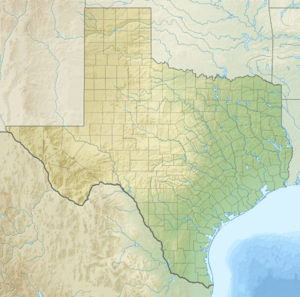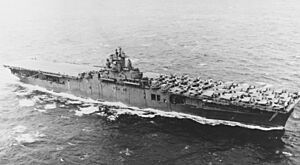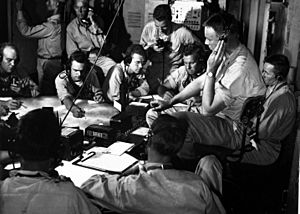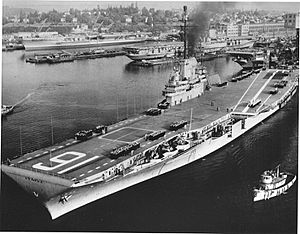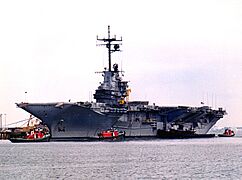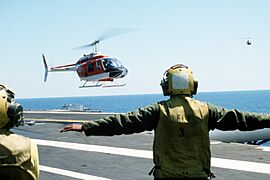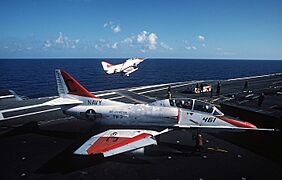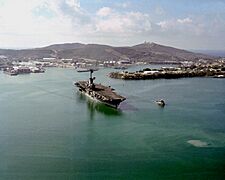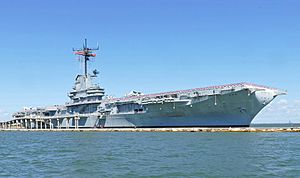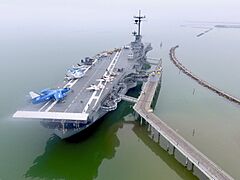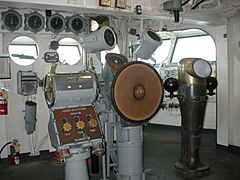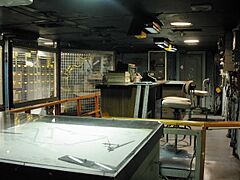USS Lexington (CV-16) facts for kids
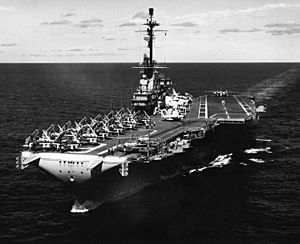
USS Lexington underway on 16 August 1958
|
|
Quick facts for kids History |
|
|---|---|
| Name | Lexington |
| Namesake |
|
| Ordered | 9 September 1940 |
| Builder | Fore River Shipyard |
| Laid down | 15 July 1941 |
| Launched | 23 September 1942 |
| Commissioned | 17 February 1943 |
| Decommissioned | 23 April 1947 |
| Recommissioned | 15 August 1955 |
| Decommissioned | 8 November 1991 |
| Reclassified |
|
| Stricken | 8 November 1991 |
| Status | Museum ship |
| General characteristics | |
| Class and type | Essex-class aircraft carrier |
| Displacement | |
| Length |
|
| Beam | 93 ft (28.3 m) |
| Draft | 34 ft 2 in (10.41 m) |
| Installed power |
|
| Propulsion |
|
| Speed | 33 knots (61 km/h; 38 mph) |
| Range | 14,100 nmi (26,100 km; 16,200 mi) at 20 knots (37 km/h; 23 mph) |
| Complement | 2,600 officers and enlisted men |
| Armament |
|
| Armor | |
| Aircraft carried |
|
|
USS Lexington Museum on the Bay
|
|
| Built | 1942 |
| NRHP reference No. | 03001043 |
| Significant dates | |
| Added to NRHP | 31 July 2003 |
| Designated NHL | 31 July 2003 |
The USS Lexington (CV/CVA/CVS/CVT/AVT-16) is a famous aircraft carrier that was built during World War II for the United States Navy. It belongs to the Essex-class of ships. The ship was first going to be named Cabot. However, it was renamed Lexington to honor an earlier ship, the USS Lexington (CV-2), which had been lost in battle. This made it the sixth U.S. Navy ship to carry the name, remembering the Battles of Lexington and Concord.
The Lexington started its service in February 1943 and played a big part in the Pacific War. It often served as the main ship for Admiral Marc Mitscher, leading the Fast Carrier Task Force through many battles. The ship earned 11 battle stars and a special award called the Presidential Unit Citation. After the war, the Lexington was taken out of service for a while.
It was later updated and brought back into service in the early 1950s. Its job changed over time, from an attack carrier (CVA) to an antisubmarine carrier (CVS). For almost 30 years, it was used as a training carrier (CVT) in Pensacola, Florida. The Lexington was finally taken out of service in 1991. It had served longer than any other Essex-class ship.
After its long career, the Lexington became a museum ship in Corpus Christi, Texas. In 2003, it was recognized as a National Historic Landmark. Even though some of its sister ships have lower numbers, the Lexington was built and started service earlier. This makes it the oldest remaining fleet carrier in the world.
Contents
Lexington in Action
World War II Service
The ship was started on July 15, 1941, in Quincy, Massachusetts. In May 1942, the earlier USS Lexington (CV-2) was sunk. Shipyard workers asked to rename the new carrier Lexington, and the Navy agreed. It was launched on September 23, 1942. The Lexington officially joined the Navy on February 17, 1943. After practicing in the Caribbean, it sailed to join the Pacific fleet.
During its first trip, a famous football player named Nile Kinnick was flying a training plane from the ship. His plane had engine trouble and crashed into the sea. Sadly, he and his plane were never found.
The Lexington arrived at Pearl Harbor in August 1943. It took part in attacks on Tarawa and Wake Island. Then, it helped with the Gilbert Islands campaign. From November 19 to 24, its planes searched for enemies and flew missions in the Marshall Islands. They shot down 29 enemy planes.
Kwajalein Attack
On December 4, the Lexington sailed to attack Kwajalein. Its morning planes destroyed a ship and damaged two cruisers. They also shot down 30 enemy aircraft. Later that day, Japanese planes attacked the carrier.
At night, Japanese planes used flares to light up the Lexington. A torpedo hit the ship, damaging its steering. Nine people sadly lost their lives. The ship tilted and smoke poured out. Crews worked quickly to seal off damaged areas. An emergency steering system was set up. The Lexington made it to Pearl Harbor for quick repairs. It then went to Bremerton, Washington, for full repairs, which finished in February 1944. After this attack, Japanese radio, known as "Tokyo Rose," falsely claimed the ship was sunk.
Battle of the Philippine Sea
The Lexington returned to duty in March 1944. It became the main ship for Rear Admiral Mitscher's new Task Force 58. The task force attacked Japanese bases in the central Pacific. The Lexington supported Army landings and raided Truk. Japanese propaganda again claimed the ship was sunk, but it was unharmed.
On June 11, a surprise attack on Saipan destroyed many enemy planes. The Lexington then fought off a strong attack by Japanese torpedo planes from Guam. Again, it was unharmed, but Japanese propaganda claimed it was sunk for a third time. The Lexington played a key role in the Battle of the Philippine Sea on June 19–20. This battle was called the "Great Marianas Turkey Shoot" because over 300 enemy planes were destroyed. This huge victory severely weakened Japanese naval aviation.
The Lexington continued to launch planes over Guam and other islands. It attacked Mindanao, the Visayas, and Manila to prepare for the attack on Leyte. Its planes also hit Okinawa and Formosa to destroy enemy bases.
Battle of Leyte Gulf
The Lexington's planes were very important in the Battle of Leyte Gulf. This was a huge naval victory for the Americans. The carrier was attacked many times but was not damaged. Its planes helped sink the Japanese "super battleship" Musashi. This was one of the largest battleships in the world. They also damaged three cruisers.
The next day, Lexington planes helped sink several Japanese aircraft carriers. They sank the light carrier Chitose and helped cripple Chiyoda. The Lexington's planes alone sank the fleet carrier Zuikaku. This was a special moment because Zuikaku's planes had helped sink the first USS Lexington (CV-2) in 1942. Later that day, Lexington planes also sank the light carrier Zuihō.
As the Japanese ships retreated, Lexington planes sank the heavy cruiser Nachi. On November 5, the Lexington faced its first kamikaze attack. A Japanese plane crashed near its command tower, causing fires. But the crew quickly put out the flames. The ship was able to keep launching planes. It even shot down another kamikaze heading for another carrier. The Lexington went to Ulithi for repairs. Tokyo again claimed it was sunk. In this attack, 50 crew members were killed and 132 were injured.
In January 1945, the Lexington attacked airfields in Luzon and Formosa. It then entered the South China Sea to hit enemy ships and air bases. Its planes sank many merchant ships and escorts. Leaving the China Sea, it attacked Formosa and Okinawa again. After getting supplies, the Lexington sailed to attack airfields near Tokyo in February 1945. It then supported the landings on Iwo Jima. The ship provided air support for the troops from February 19 to 22. After more attacks on Japan, it went for repairs.
End of World War II
The Lexington returned to battle on May 22. It joined a task force for the final air strikes against Japan. These attacks lasted until August 15, when Japan surrendered. During this time, its planes attacked airfields and naval bases in Japan. They helped destroy the remaining Japanese fleet. In one action, planes from Lexington sank the battleship/aircraft carrier Ise.
After the war ended, Lexington planes flew patrols over Japan. They also located and dropped supplies to prisoner-of-war camps. In December, the ship was used to bring servicemen home in Operation Magic Carpet. It arrived in San Francisco on December 16.
After World War II
The Lexington was taken out of service on April 23, 1947. It was kept in a special reserve fleet. In 1953, the ship went into the Puget Sound Naval Shipyard for a major upgrade. It received SCB-27C and SCB-125 conversions. These changes allowed it to operate modern jet aircraft. The most noticeable changes were an angled flight deck, steam catapults, a new command tower, and a special "hurricane bow."
The Lexington was brought back into service on August 15, 1955. It was based in San Diego and operated off California. It then sailed for a six-month deployment with the 7th Fleet in the Far East. It returned to San Diego on December 20.
In 1958, during the Second Taiwan Strait Crisis, the Lexington was sent to reinforce the 7th Fleet off Taiwan. It was the first carrier whose planes carried AGM-12 Bullpup guided missiles. It also helped during the Laotian crisis in 1959.
In January 1962, the Lexington was chosen to become an aviation training carrier. It was reclassified as CVS-16 on October 1, 1962. However, during the Cuban Missile Crisis, it briefly returned to duty as an attack carrier. It officially became a training carrier in Pensacola, Florida, on December 29, 1962.
For the next 22 years, the Lexington operated out of Pensacola and Corpus Christi. Its main job was to train student aviators for the Navy and Marine Corps. This work was very important, especially for pilots serving in Vietnam. On October 17, 1967, the Lexington completed its 200,000th arrested landing (a landing where a plane is stopped by wires). It was reclassified as CVT-16 in 1969 and AVT-16 in 1978. It continued as a training carrier until 1991.
On August 18, 1980, the Lexington made history. It became the first aircraft carrier in the U.S. Navy to have women serving as crew members. In 1989, a training aircraft had an accident during a landing attempt. It hit the ship's command tower, and sadly, some lives were lost. The crew quickly put out the fires, and the ship was able to continue its important work. The Lexington was the last Essex-class carrier still in service when it was decommissioned on November 8, 1991.
USS Lexington Museum
On November 26, 1991, the U.S. Navy gave the Lexington to the City of Corpus Christi. On June 15, 1992, the ship became a museum. It is now known as the "USS Lexington Museum on the Bay" in Corpus Christi, Texas. The museum has a large theater, similar to an IMAX theater, in one of the old aircraft elevator spaces.
In 2003, the Lexington was named a National Historic Landmark. The ship is well-cared for, and new parts of the ship are opened to the public every few years. For example, visitors can now see the catapult room.
The museum is also restoring some of the ship's World War II-era guns. These guns were saved from other scrapped ships. They are placed where similar guns would have been during the war.
The National Naval Aviation Museum in Pensacola, Florida, has a small model of a carrier deck. This model's flight deck is made from real deck boards taken from the Lexington.
Awards and Honors
The crew of the Lexington received the Presidential Unit Citation for their bravery in battles against Japanese forces. The ship also earned 11 battle stars for its major engagements during World War II. It received several other awards for its service.
| Presidential Unit Citation | ||
| Meritorious Unit Commendation with one star |
Navy Expeditionary Medal | China Service Medal |
| American Campaign Medal | Asiatic-Pacific Campaign Medal with eleven stars |
World War II Victory Medal |
| Navy Occupation Service Medal with "Asia" Clasp |
National Defense Service Medal with one star |
Armed Forces Expeditionary Medal with two stars |
| Special Operations Service Ribbon | Philippine Presidential Unit Citation | Philippine Liberation Medal with two stars |
See also
 In Spanish: USS Lexington (CV-16) para niños
In Spanish: USS Lexington (CV-16) para niños
- U.S. Navy museums (and other aircraft-carrier museums)
- List of National Historic Landmarks in Texas
- National Register of Historic Places listings in Nueces County, Texas


